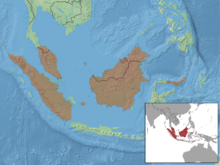Prevost's squirrel
| Prevost's squirrel | |
|---|---|

| |
| Typical form of Prevost's squirrel | |
| Scientific classification | |
| Domain: | Eukaryota |
| Kingdom: | Animalia |
| Phylum: | Chordata |
| Class: | Mammalia |
| Order: | Rodentia |
| Family: | Sciuridae |
| Genus: | Callosciurus |
| Species: | C. prevostii
|
| Binomial name | |
| Callosciurus prevostii (Desmarest, 1822)
| |
| Subspecies | |
|
See text | |

| |
| Distribution in red | |
Prevost's squirrel or Asian tri-coloured squirrel (Callosciurus prevostii) is a colourful species of rodent in the family Sciuridae. It is found in forests in the Thai-Malay Peninsula, Sumatra, Borneo and nearby smaller islands, with an introduced population in northern Sulawesi. Although the Prevost's squirrel is declining in some regions because of habitat loss and hunting, the species is not considered threatened since it generally remains common and widespread.[1] It can live in somewhat disturbed habitats and often visits plantations or gardens. It mostly feeds on plant material, especially fruits, but also takes insects.[2]
Appearance and taxonomy
The Prevost's squirrel is a medium-sized squirrel, but one of the larger species in its range, although clearly surpassed by the
In general, the
As many as 44 subspecies have been named for the Prevost's squirrel,
Behaviour
The Prevost's squirrel is active during the day and mostly stays in trees, only occasionally moving on the ground.[5] The 1–3 young are born after a gestation that lasts around seven weeks.[2] The nest is made of sticks, bark and grass.[6]
Feeding
This squirrel eats fruits, nuts, seeds, buds, flowers, insects and bird eggs.[8] They have been observed feeding on durians such as Durio graveolens.[9] These squirrels carry the fruits far from the tree and drop the seeds when finished with their meal. This seed distribution away from the parent plant increases survival for the fruiting plant species.[2]
References
- ^ . Retrieved 15 November 2021.
- ^ .
- ^ ISBN 967-99947-1-6.
- ^ ISBN 978-1-4214-0469-1.
- ^ ISBN 978-0-691-13551-9.
- ^ ISBN 978-0691169415.
- ^ Wilson, Don E.; Reeder, DeeAnn M., eds. (2005). "Mammal Species of the World. A Taxonomic and Geographic Reference". Mammal Species of the World - Search (Third ed.). Bucknell University. Retrieved 17 July 2018.
- ^ Hoffman, H. (2003). "Callosciurus prevostii – Prevost's squirrel". Animal Diversity Web. Retrieved 18 November 2019.
- S2CID 82212472.




